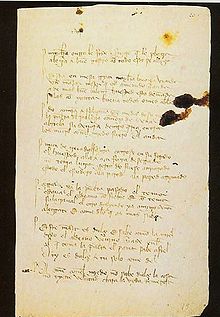You can help expand this article with text translated from the corresponding article in Spanish. (November 2015) Click [show] for important translation instructions.
|
 | |
| Author | Juan Ruiz Archpriest of Hita |
|---|---|
| Original title | El libro del buen amor |
| Language | Medieval Spanish |
| Genre | mester de clerecía |
| Publisher | None |
Publication date | 1330; expansion completed 1343 |
| Publication place | Spain |
| Media type | Manuscript |
The Book of Good Love (Spanish: El libro de buen amor), considered to be one of the masterpieces of Spanish poetry,[1] is a pseudo-biographical account of romantic adventures by Juan Ruiz, the Archpriest of Hita,[2] the earliest version of which dates from 1330; the author completed it with revisions and expansions in 1343.[3]
The work is considered as the best piece in the medieval genre known as mester de clerecía.
The Book begins with prayers and a guide as to how to read the work, followed by stories each containing a moral and often comical tale.
The book contains a heterogeneous collection of various materials united around an alleged autobiographical narrative of the love affairs of the author, who is represented by the episodic character of Don Melón de la Huerta in part of the book. In the book, all layers of late medieval Spanish society are represented through their lovers.
Fables and apologues are interspersed throughout the course of the main argument that constitute a collection of exempla. Likewise, you can find allegories, moralities, sermons, and songs of the blind and of Goliardic- type schoolchildren. Profane lyrical compositions (serranillas, often parodic, derived from the pastorelas) are also included alongside other religious ones, such as hymns and couplets to the Virgin or Christ.
The narrative materials are based on the parody of medieval elegiac comedies in Latin from a pseudo-Ovidian school setting, such as De vetula and Pamphilus, in which the author is the protagonist of amorous adventures that alternate with poems related to him or her. Pamphilus is also cited in the Book of Good Love as the basis for the episode of Don Melón and Doña Endrina. In addition to materials derived from Ovid’s Ars Amatoria, it also parodies the liturgy of the canonical hours or epics and in combat of Carnival ("Don Carnal") and Lent ("Doña Cuaresma"). Other genres that can be found in the Book are planhz, such as Trotaconventos' death, a character that constitutes the clearest precedent for La Celestina or satires, such as those directed against female owners or the equalizing power of money; or fables, from the medieval aesopic tradition or pedagogical manuals, such as Facetus, which considers romantic education as part of human learning. Although Arabic sources have been proposed, current criticism favors the belief that The Book of Good Love descends from medieval clerical Latin literature.
- ^ Kryzskowska-Pawlik, Rosanna; Palka, Ewa; Stala, Ewa (October 2011). "Juan Ruiz, Arcipreste de Hita: Libro de Buen Amor, la obra maestra del Medioevo español". In Eminowicz-Jaśkowska, Teresa (ed.). La Edad de Plata del hispanismo cracoviano. Textos y contextos [The Silver Age of Hispanic Studies in Cracow. Texts and contexts] (PDF) (in Spanish). Vol. 10. Jagiellonian University. pp. 239–253. doi:10.12797/SI.10.2011.10.18. ISSN 2082-8594.
{{cite book}}:|journal=ignored (help) - ^ "Libro de buen amor, de Juan Ruiz, arcipreste de Hita". Real Academia Española (in Spanish). Retrieved 18 September 2018.
- ^ Pérez Priego, Miguel Ángel. "Arcipreste de Hita. El autor y su obra". Biblioteca Virtual Miguel de Cervantes. Fundación Biblioteca Virtual Miguel de Cervantes. Retrieved 18 September 2018.